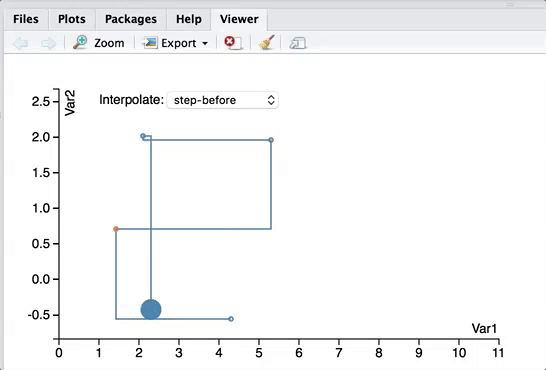https://github.com/yonicd/shinyCanvas
https://github.com/yonicd/shinyCanvas
Last synced: 2 months ago
JSON representation
- Host: GitHub
- URL: https://github.com/yonicd/shinyCanvas
- Owner: yonicd
- License: other
- Created: 2017-02-28T18:13:57.000Z (over 8 years ago)
- Default Branch: master
- Last Pushed: 2017-11-17T14:49:27.000Z (over 7 years ago)
- Last Synced: 2024-01-28T23:08:58.932Z (over 1 year ago)
- Language: R
- Size: 10.4 MB
- Stars: 22
- Watchers: 7
- Forks: 3
- Open Issues: 0
-
Metadata Files:
- Readme: README.md
- License: LICENSE
Awesome Lists containing this project
- awesome-shiny-extensions - shinyCanvas - Create and customize an interactive canvas using the D3 JavaScript library and the htmlwidgets package. (UI Components / Advanced Interactivity)
README
# shinyCanvas
Create and customize an interactive canvas using the 'D3' JavaScript library and the 'htmlwidgets' package.
The canvas can be used directly from the R console, from 'RStudio', in Shiny apps and R Markdown documents.
When in Shiny the canvas is observed by the server and can be used as a functional slider (with animation) to work in a two dimensional space.
The main objective is to create a new object for Shiny that represents a functional slider extending the one dimensional `shiny::sliderInput`.
For an interactive bl.ock page to try the d3js code go to [here](https://bl.ocks.org/yonicd/4bc59fca901388ebe4905bdb19af1567).

The user inputs a data.frame that contains corrdinates x,y and then can:
- add/remove points to the plot
- change position of the points
- change the type of interpolation between points
- run animation on the interpolated curve to collect a sample from it
## Usage as an htmlwidget in the RStudio viewer
```
canvas(obj = data.frame(x=1:10,y=runif(10)))
```
## Usage in a Shiny app
When run in the Shiny environment, Shiny is observing the points and returns to the server their x,y mapping. So instead of predefining scenarios in simulations you can let the user define the relationship between two variables.
#### Reactive Canvas:


### Click Pictures to see Youtube Videos
#### Basic Usage:
Script to run example below
[](https://www.youtube.com/watch?v=obfjcYty7vk)
##### Survival Analysis Example:
[](https://www.youtube.com/watch?v=56Ee_2MdptI)
```
library(shinyCanvas)
library(shiny)
server <- function(input, output) {
network <- reactiveValues()
df<-reactive({
data.frame(Var1=1:10,Var2=sort(rexp(10),decreasing = T))
})
observeEvent(input$d3_update,{
netNodes=input$d3_update$.pointsData
if(!is.null(netNodes)) network$nodes <- jsonlite::fromJSON(netNodes)
pathNodes=input$d3_update$.pathData
if(!is.null(pathNodes)) network$path <- jsonlite::fromJSON(pathNodes)
})
observeEvent(network$nodes,{
output$pointsOut<-renderTable({
dat=network$nodes
colnames(dat)=names(df())
dat.df=data.frame(Id=1:nrow(dat),dat)
dat.df
})
})
observeEvent(network$path,{
output$pathOut<-renderTable({
dat=as.data.frame(network$path)
colnames(dat)=names(df())
dat=data.frame(Id=1:nrow(dat),dat)
dat
})
})
output$d3 <- renderCanvas({
isolate({canvas(obj = df(),animate = TRUE,duration=500,pathRadius=10)})
})
}
ui <- fluidPage(
column(6,canvasOutput(outputId="d3")),
column(3,
p('Plot Points'),
tableOutput('pointsOut')
),
column(3,
p('Path Sample'),
tableOutput('pathOut')
)
)
shinyApp(ui = ui, server = server)
```